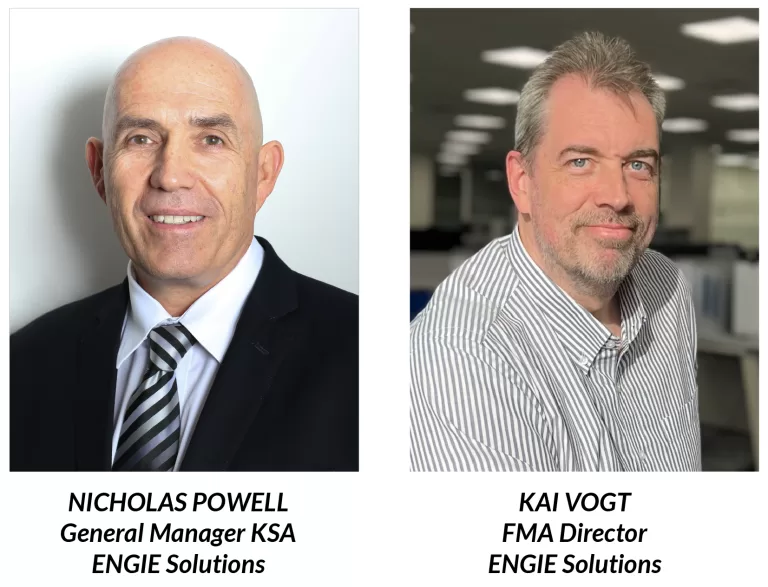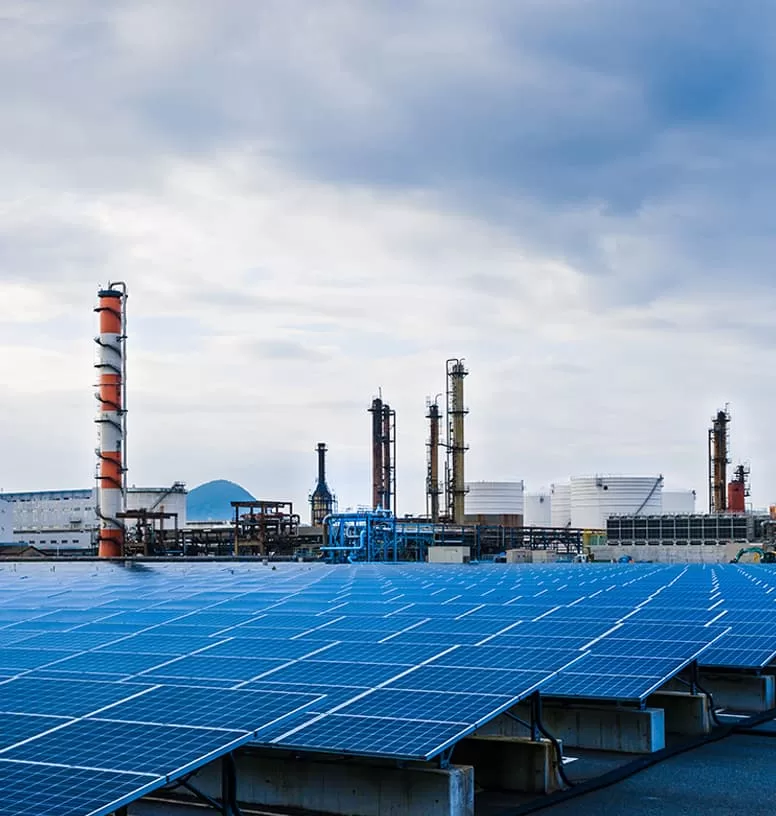
Search
People also search for:
quick contact:
were on social media:
Pioneering the Path to Decarbonization

By Pierre Cheyron
Managing Director, Africa, Middle East and Asia, ENGIE Energy Solutions
The manufacturing sector’s role in a sustainable future.
The world is facing a climate emergency, and every sector must play its part in reducing greenhouse gas emissions. However, some sectors are harder to decarbonise than others, especially heavy industries such as steel, cement, and chemicals, owing to technical factors like the need for extremely high heat and process emissions of carbon dioxide.
While central to our modern way of life, these industries are responsible for nearly 40% of global carbon dioxide (CO₂) emissions. Moreover, the industrial sector provides various essential materials required for a sustainable energy sector transition – steel, plastics and cement are used for various clean energy technologies and infrastructure, including electric vehicles, wind turbines and solar panels. Therefore, these sectors need innovative and alternative solutions to achieve net-zero goals.
One such solution is Waste Heat Recovery (WHR), which converts the thermal energy that is otherwise wasted in industrial processes into useful electricity. WHR not only reduces a plant’s fuel consumption, emissions, and electricity demand from the grid but is also a sustainable and profitable solution, enhancing operational efficiency and lowering energy costs.
An example of WHR in action is Holcim UAE’s LEC cement plant, which implemented with ENGIE a 9MW WHR project based on the Organic Rankine Cycle (ORC) technology. ORC uses an organic fluid instead of water as the working fluid, which allows it to operate with low-temperature waste heat and without water. The project, expected to be completed early next year, will help LEC avoid 29 kilotons of CO2 emissions per year, representing a 28% reduction in power-related emissions.
The project also aligns with the UAE’s sustainability goals, including the 2050 Net Zero vision, which aims to achieve net-zero emissions by 2050. The UAE has set ambitious targets in adopting renewable energy, energy efficiency, and low-carbon technologies, such as solar, hydrogen, and carbon capture and storage. Such goals have gained renewed focus as the UAE hosts COP28 this year.
The project is based on a 10-year BOOT (Build Own Operate Transfer) contract, where ENGIE Solutions designs, finances, constructs, and manages the operations of the WHR system and provides LEC with clean electricity at a competitive price. This “energy-as-a-service” financing model allows LEC to benefit from guaranteed energy savings, enhanced reliability, and resiliency without significant capital investment or additional staffing requirements. Under a BOOT structure, off-takers such as LEC only need to provide ENGIE with a nearby site, accept the connection to ENGIE’s energy system, and purchase the electricity produced by this system, similar to any utility arrangement.
Power decarbonization and maximize business value with distributed solar PV
Solar energy serves as a potent instrument in the effort to decarbonise industry by supplying clean and cost-effective electricity for industrial processes. This enhances the operational efficiency and profitability of industrial facilities and positively influences their environmental and social impact. By facilitating the transition to a net-zero future, solar energy emerges as a pivotal player in global climate action, contributing significantly to a sustainable and responsible industrial landscape.
Distributed solar, characterised by its proximity to the point of consumption, whether on rooftops or ground-mounted systems, provides electricity to factories and reduces their dependence on carbon-heavy, expensive energy sources such as diesel fuel. The result is a substantial reduction in emissions tied to electricity consumption within industrial facilities.
Distributed Solar energy is increasingly becoming more attractive for the industrial sector due to several factors. The consistent and notable decline in the cost of solar panels over the past decade has rendered solar power exceptionally competitive. Advancements in solar panel technology and efficiency have enabled these systems to harness more sunlight and generate more electricity, all while minimising the required land footprint. Additionally, the development and deployment of energy storage systems, such as batteries or thermal storage, facilitate the storage of surplus solar power, allowing its utilisation during periods of low sunlight, such as at night or during cloudy days, or to turn off diesel generators completely.
Solar PV dominates renewable energy capacity addition. According to the International Energy Agency (IEA), solar PV accounted for about 65% of global renewable energy capacity growth in 2022 and is expected to provide more than half of the renewable capacity additions through 2026.
In the GCC, Saudi Arabia is at the forefront of the renewable energy transition in the region. The country has ambitious plans to invest in renewables in the current decade to achieve net-zero emissions by 2030. Saudi Arabia also aims to abate up to 130 million tonnes of carbon dioxide equivalent (MtCO2 e) annually, with $270 billion allocated for low-carbon energy projects by 2030.
Aligned with the country’s vision, NADEC, one of the largest agricultural and food processors in the Middle East, deployed one of the largest corporate power purchase agreement (PPA) projects for solar energy in the region. This initiative, structured under the BOOT framework for 25 years, allows NADEC to procure electricity from a 30 MWp solar PV facility developed and owned by ENGIE. It not only reduces the company’s fuel consumption by 124,000 barrels of oil equivalent per year but also contributes to a reduction of 53,000 tons in carbon emissions annually.
The NADEC project underscores the compelling competitiveness of solar energy as a viable alternative to fossil fuels, even for medium-sized PV power plants. Notably, this project has generated broad interest, resulting in a pipeline of similar opportunities across the MENA region. By doing so, it actively aligns with the global commitment to curbing CO2 emissions while substantially contributing to the realisation of renewable energy goals outlined in Saudi Vision 2030.
These projects demonstrate the effectiveness of innovative financing solutions and collaborative partnerships in enabling organisations to embark on energy transition projects. They are also a testament to both the potential and feasibility of decarbonising the manufacturing sector, showcasing the necessary collaboration and innovation required to achieve cost reductions and play a pivotal role in transitioning towards a net-zero future.
Source: Khaleej Times: Pioneering the Path to Decarbonisation

This shift from standard FM hierarchies has been pivotal to ENGIE’s success, showcasing adaptability and innovation in the face of adversity. Subsequently, ENGIE’s FMA team implemented a transformative approach by recruiting Subject Matter Experts (SMEs) with deep expertise in various domains – from transportation logistics, catering services, pest control, waste management, or soft and hard services – fostering teamwork, knowledge-sharing, and collective pursuit of service excellence. This strategic assembly of world-class SMEs enabled the team to swiftly navigate the challenges of a dynamic environment and balance cost-effectiveness with practical, solution-oriented strategies.
Nicholas Powell, General Manager KSA for ENGIE Solutions, reflects on the initiative: “Our proactive involvement was key to adapting our services to IMI’s demands, significantly contributing to the project’s success.”
The seamless coordination between IMI and stakeholders, including clients, contractors, suppliers, and key personnel, empowered IMI FM&SS and ENGIE Solutions teams to swiftly address and surmount challenges. By aligning goals and collaborating closely, the ENGIE FMA team was able to tailor facility management services based on IMI’s unique requirements.
Faced with the complex task of delivering comprehensive services for a large project, the ENGIE FMA team innovated beyond conventional boundaries, subsequently developing Bespoke Pricing Methodologies. The resultant specialized pricing methodologies deviated from standard lump sum or unit rate contracts, ensuring cost-efficiency, fairness, and transparency. By integrating these methodologies into contracts, the ENGIE FMA team established a consistent framework for commercial evaluation, boosting both efficiency and effectiveness.
Powell stressed the mutual benefits of the innovative pricing strategies for both IMI and ENGIE FMA. He said the approach ensured cost control and efficient invoicing for the client while providing ENGIE FMA with a transparent and equitable compensation model.
ENGIE Innovations
Prioritizing health and safety, the ENGIE FMA team created an adaptable Risk Assessment mobile application. Customized by ENGIE, the tool has been integrated with various systems, including the IMI Computer Aided Facility Management (CAFM) system. The app allows for comprehensive risk assessments during task execution, offering users pre-set templates based on the task at hand, assessing potential hazards, and applying corresponding control measures.
ENGIE Solutions’ forward-thinking strategy for the IMI project also involved implementing SMART O&M and IoT integration to elevate facility management by utilizing cutting-edge technology to continuously monitor and enhance facility operations. IoT devices throughout the complex provide critical data on energy usage, equipment functionality, and environmental conditions, facilitating proactive management and maintenance.
Further, the synergy of SMART O&M and IoT enables ENGIE Solutions to achieve exceptional operational efficiency and cost-effectiveness. The benefits include real-time oversight, automated processes, and intelligent controls, leading to energy optimization, minimized downtime, and better resource management. These advanced technologies position IMI at the forefront of innovation and set new industry standards.
Creating Excellence Together
Vogt commends the joint efforts of IMI’s Facilities Management and Support Services team (FM&SS) and the ENGIE FMA team. “We are immensely proud of the collaborative efforts. Together, we have set new industry benchmarks and successfully raised the bar for Facilities Management excellence,” he added.
Looking ahead, both ENGIE Solutions and IMI are committed to continued innovation and adaptation to meet the evolving demands of the community. By fostering a strong partnership, they aim to enhance the living experience further and exceed expectations.
Source: Built Environment ME magazine: Unblock Possibilities
webincorp